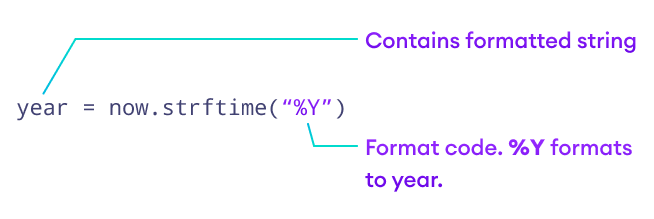The strftime() method returns a string representing date and time using date, time or datetime object.
Example 1: datetime to string using strftime()
The program below converts a datetime object containing current date and time to different string formats.
from datetime import datetime
now = datetime.now() # current date and time
year = now.strftime("%Y")
print("year:", year)
month = now.strftime("%m")
print("month:", month)
day = now.strftime("%d")
print("day:", day)
time = now.strftime("%H:%M:%S")
print("time:", time)
date_time = now.strftime("%m/%d/%Y, %H:%M:%S")
print("date and time:",date_time)
When you run the program, the output will something like be:
year: 2018 month: 12 day: 24 time: 04:59:31 date and time: 12/24/2018, 04:59:31
Here, year, day, time and date_time are strings, whereas now is a datetime object.
How strftime() works?
In the above program, %Y, %m, %d etc. are format codes. The strftime() method takes one or more format codes as an argument and returns a formatted string based on it.
- We imported
datetimeclass from thedatetimemodule. It's because the object ofdatetimeclass can accessstrftime()method.

- The
datetimeobject containing current date and time is stored in now variable.

- The
strftime()method can be used to create formatted strings.

- The string you pass to the
strftime()method may contain more than one format codes.

Example 2: Creating string from a timestamp
from datetime import datetime
timestamp = 1528797322
date_time = datetime.fromtimestamp(timestamp)
print("Date time object:", date_time)
d = date_time.strftime("%m/%d/%Y, %H:%M:%S")
print("Output 2:", d)
d = date_time.strftime("%d %b, %Y")
print("Output 3:", d)
d = date_time.strftime("%d %B, %Y")
print("Output 4:", d)
d = date_time.strftime("%I%p")
print("Output 5:", d)
When you run the program, the output will be:
Date time object: 2018-06-12 09:55:22 Output 2: 06/12/2018, 09:55:22 Output 3: 12 Jun, 2018 Output 4: 12 June, 2018 Output 5: 09AM
Format Code List
The table below shows all the codes that you can pass to the strftime() method.
| Directive | Meaning | Example |
%a |
Abbreviated weekday name. | Sun, Mon, ... |
%A |
Full weekday name. | Sunday, Monday, ... |
%w |
Weekday as a decimal number. | 0, 1, ..., 6 |
%d |
Day of the month as a zero-padded decimal. | 01, 02, ..., 31 |
%-d |
Day of the month as a decimal number. | 1, 2, ..., 30 |
%b |
Abbreviated month name. | Jan, Feb, ..., Dec |
%B |
Full month name. | January, February, ... |
%m |
Month as a zero-padded decimal number. | 01, 02, ..., 12 |
%-m |
Month as a decimal number. | 1, 2, ..., 12 |
%y |
Year without century as a zero-padded decimal number. | 00, 01, ..., 99 |
%-y |
Year without century as a decimal number. | 0, 1, ..., 99 |
%Y |
Year with century as a decimal number. | 2013, 2019 etc. |
%H |
Hour (24-hour clock) as a zero-padded decimal number. | 00, 01, ..., 23 |
%-H |
Hour (24-hour clock) as a decimal number. | 0, 1, ..., 23 |
%I |
Hour (12-hour clock) as a zero-padded decimal number. | 01, 02, ..., 12 |
%-I |
Hour (12-hour clock) as a decimal number. | 1, 2, ... 12 |
%p |
Locale’s AM or PM. | AM, PM |
%M |
Minute as a zero-padded decimal number. | 00, 01, ..., 59 |
%-M |
Minute as a decimal number. | 0, 1, ..., 59 |
%S |
Second as a zero-padded decimal number. | 00, 01, ..., 59 |
%-S |
Second as a decimal number. | 0, 1, ..., 59 |
%f |
Microsecond as a decimal number, zero-padded on the left. | 000000 - 999999 |
%z |
UTC offset in the form +HHMM or -HHMM. | |
%Z |
Time zone name. | |
%j |
Day of the year as a zero-padded decimal number. | 001, 002, ..., 366 |
%-j |
Day of the year as a decimal number. | 1, 2, ..., 366 |
%U |
Week number of the year (Sunday as the first day of the week). All days in a new year preceding the first Sunday are considered to be in week 0. | 00, 01, ..., 53 |
%W |
Week number of the year (Monday as the first day of the week). All days in a new year preceding the first Monday are considered to be in week 0. | 00, 01, ..., 53 |
%c |
Locale’s appropriate date and time representation. | Mon Sep 30 07:06:05 2013 |
%x |
Locale’s appropriate date representation. | 09/30/13 |
%X |
Locale’s appropriate time representation. | 07:06:05 |
%% |
A literal '%' character. | % |
Example 3: Locale's appropriate date and time
from datetime import datetime
timestamp = 1528797322
date_time = datetime.fromtimestamp(timestamp)
d = date_time.strftime("%c")
print("Output 1:", d)
d = date_time.strftime("%x")
print("Output 2:", d)
d = date_time.strftime("%X")
print("Output 3:", d)
When you run the program, the output will be:
Output 1: Tue Jun 12 09:55:22 2018 Output 2: 06/12/18 Output 3: 09:55:22
Format codes %c, %x and %X are used for locale's appropriate date and time representation.
We also recommend you to check Python strptime(). The strptime() method creates a datetime object from a string.